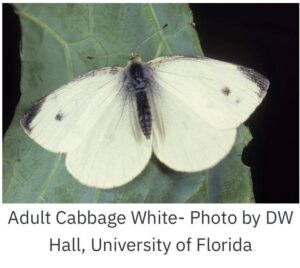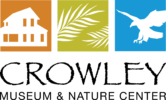Phone: 941-322-1000 | Email: [email protected]
Wildlife Wednesday – Cabbage White
In today’s installment of Wildlife Wednesday we will discuss the delightful little Cabbage White butterfly
(Pieris rapae [Linnaeus])
This butterfly is the species featured in yesterday’s facebook post, fluttering in abundance around the fading collard green plants in our agroforestry demo. Butterflies themselves, in their adult form , pose no threat to anyone. Rather, they are a benefit as pollinators and even food for other species. Their caterpillars (larvae) however, can be considered agricultural pests. This is often the case with the cabbage white. The green caterpillars with their yellow stripes eat several host plants in the mustard family (Brassicaceae) and sometimes some in caper family (Capparidaceae). The problem? We do too. Broccoli, cauliflower (both human created), cabbage, collards and so on. Hence the problem, and their assignment as an agricultural pests. The caterpillars can decimate crops once they’re established. Unfortunately the chemical controls people use often kill many other harmless invertebrate species. Fortunately there is another option, especially for home and hobby gardens – application of floating row covers.

Adult butterfly wingspan ranges from about 3-5cm. While they are commonly called “cabbage whites,” they also have grey, yellow and sometimes even greenish coloration. Pieris rapae is also a sexually dimorphic species, males and females can be distinguished visually. Both sexes have submarginal black spots. The difference is females have two, males have one. The males troll over host plants looking for females who, after fertilization lay single eggs on the underside of host plant leaves. Adults live approximately 3 weeks, pollinating many flower species in their lifetimes.
In our garden we don’t use chemical controls. While sometimes Mr Noah will remove pests manually, we often leave the job to nature. We not only tolerate the presence of predators such as wasps and spiders, but we encourage them. Nature often can balance herself. Additionally, the collards they have discovered are at the end of their cycle, they are a winter crop and we are well into summer. We let them go for several reasons. We use them to feed chickens and fertilize back to the garden as part of the agroforestry model. So, we do not mind sharing our leftovers with this native pollinator species. While they discover our old collards and court each other, they feed on what is currently blooming. This pollination results in fruits and vegetables for us and other animals. Soon we will have cabbage whites to thank, in part for the next harvest we all benefit from. Finally, these butterflies and caterpillars are not only themselves, creators of food, they are food. Then also their dead bodies and frass (poop), are natural fertilizer.

These little creatures add a delightful element to an already beautiful and beneficial space. We ask that whenever possible, you fully consider the lives of all wildlife and try to naturally co-exist.
To support our mission in conservation and education and to have your donation doubled at no additional cost to you please go here-
